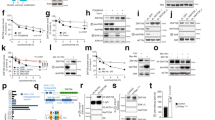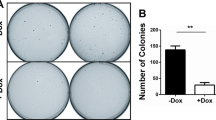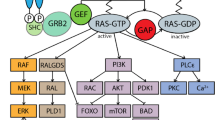Abstract
Resistance of primary cells to transformation by oncogenic Ras has been attributed to the induction of replicative growth arrest1,2,3. This irreversible 'fail-safe mechanism' resembles senescence and requires induction by Ras of p19ARF and p53 (refs 3–5). Mutation of either p19ARF or p53 alleviates Ras-induced senescence and facilitates oncogenic transformation by Ras3,6,7. Here we report that, whereas Rb and p107 are each dispensable for Ras-induced replicative arrest, simultaneous ablation of both genes disrupts Ras-induced senescence and results in unrestrained proliferation. This occurs despite activation by Ras of the p19ARF/p53 pathway, identifying pRb and p107 as essential mediators of Ras-induced antiproliferative p19ARF/p53 signalling. Unexpectedly, in contrast to p19ARF or p53 deficiency, loss of Rb/p107 function does not result in oncogenic transformation by Ras, as Ras-expressing Rb−/−/p107−/− fibroblasts fail to grow anchorage-independently in vitro and are not tumorigenic in vivo. These results demonstrate that in the absence of both Rb and p107 cells are resistant to p19ARF/p53-dependent protection against Ras-induced proliferation, and uncouple escape from Ras-induced premature senescence from oncogenic transformation.
This is a preview of subscription content, access via your institution
Access options
Subscribe to this journal
Receive 12 print issues and online access
$209.00 per year
only $17.42 per issue
Buy this article
- Purchase on Springer Link
- Instant access to full article PDF
Prices may be subject to local taxes which are calculated during checkout




Similar content being viewed by others
References
Newbold, R. F. & Overell, R. W. Nature 304, 648–651 (1983).
Franza, B. R., Maruyama, K., Garrels, J. I. & Ruley, H. E. Cell 44, 409–418 ( 1986).
Serrano, M., Lin, A. W., McCurrach, M. E., Beach, D. & Lowe, S. W. Cell 88, 593–602 (1997).
Palmero, I., Pantoja, C. & Serrano, M. Nature 395, 125– 126 (1998).
Sherr, C. J. Genes Dev. 12, 2984–2991 (1998).
Kamijo, T. et al. Cell 91, 649–659 (1997).
Tanaka, N. et al. Cell 77, 829–839 (1994).
Weinberg, R. A. Cell 88, 573–575 ( 1997).
Chin, L. et al. Genes Dev. 11, 2822–2834 (1997).
Land, H., Parada, L. F. & Weinberg, R. A. Nature 304, 596– 602 (1983).
Ruley, H. E. Nature 304, 602–606 ( 1983).
Weinberg, R. A. Cancer Res. 49, 3713–3721 (1989).
Peeper, D. S. et al. Nature 386, 177–181 (1997).
Serrano, M. et al. Cell 85, 27–37 (1996).
Noda, A., Ning, Y., Venable, S. F., Pereira-Smith, O. M. & Smith, J. R. Exp. Cell Res. 211, 90– 98 (1994).
Hara, E. et al. Mol. Cell. Biol. 16, 859– 867 (1996).
Herrera, R. E. et al. Mol. Cell. Biol. 16, 2402– 2407 (1996).
Lu, X., Park, S. H., Thompson, T. C. & Lane, D. P. Cell 70, 153–161 ( 1992).
Robanus-Maandag, E. et al. Genes Dev. 12, 1599– 1609 (1998).
Bates, S. et al. Nature 395, 124–125 (1998).
Carnero, A., Hudson, J. D., Price, C. M. & Beach, D. H. Nature Cell Biol. 2, 148–155 (2000).
te Riele, H., Maandag, E. R. & Berns, A. Proc. Natl Acad. Sci. USA 89, 5128–5132 (1992).
Dannenberg, J. H., van Rossum, A., Schuijff, L. & te Riele, H. Genes Dev. 14, 3051–3064 (2000).
Morgenstern, J. P. & Land, H. Nucleic Acids Res. 18, 3587–3596 ( 1990).
Kanda, T., Sullivan, K. F. & Wahl, G. M. Curr. Biol. 8, 377– 385 (1998).
van den Heuvel, S. & Harlow, E. Science 262, 2050–2054 (1993).
Acknowledgements
We thank M. Dekker-Vlaar, K. van't Wout and the animal facility (Netherlands Cancer Institute) for help with generating chimaeric mice, isolating and preparing mouse embryos and tumour-induction experiments, J. Jonkers for providing p53−/− MEFs, R. A. DePinho, P. Krimpenfort and J. Jacobs for INK4a−/− MEFs, C. J. Sherr for ARF−/− MEFs, J-W. Voncken, E. Wientjes and E. Verhoeven for Ras and Myc retroviral vectors, G. Nolan for retroviral packaging cells, our colleagues for helpful discussions, and A. Berns for critically reading the manuscript. D.S.P., J-H.D. and S.D. were supported by grants from the Dutch Cancer Society (KWF).
Author information
Authors and Affiliations
Corresponding author
Rights and permissions
About this article
Cite this article
Peeper, D., Dannenberg, JH., Douma, S. et al. Escape from premature senescence is not sufficient for oncogenic transformation by Ras. Nat Cell Biol 3, 198–203 (2001). https://doi.org/10.1038/35055110
Received:
Revised:
Accepted:
Published:
Issue Date:
DOI: https://doi.org/10.1038/35055110
This article is cited by
-
Uncoupling Oncogene-Induced Senescence (OIS) and DNA Damage Response (DDR) triggered by DNA hyper-replication: lessons from primary mouse embryo astrocytes (MEA)
Scientific Reports (2017)
-
PAX8 promotes tumor cell growth by transcriptionally regulating E2F1 and stabilizing RB protein
Oncogene (2011)
-
Oncogenic pathways impinging on the G2-restriction point
Oncogene (2008)
-
Rb function is required for E1A-induced S-phase checkpoint activation
Cell Death & Differentiation (2008)
-
Regulation of cellular senescence by Rb2/p130
Oncogene (2006)



